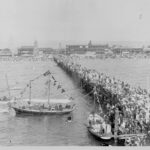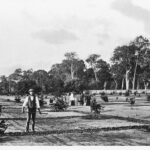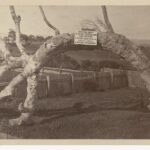Wakefield’s Vision
Ideas for a new system of colonisation were generated by the adventurer Edward Gibbon Wakefield during his imprisonment in Newgate Gaol in London. What had gone wrong in Canada, South Africa and the existing Australian colonies, Wakefield alleged, was that too many wage-earners had become independent proprietors, making labour ‘extravagantly dear’. Free land grants should cease. Land should be sold, and sold at a price high enough to prevent farmhands from becoming landowners until they had worked for wages for several years at the very least. Only those who were conscientious, thrifty and sober should have a chance of accumulating enough capital to change their station in life. Wakefield thought ‘some kind of slavery’ was necessary for civilisation to flourish: there should always be a pool of unemployed, to prevent wage rises and keep most labourers in ‘that natural subordination in which the greater part of mankind always have been, and probably always will be’. He long dithered over what would be a ‘sufficient price’ for land and also kept changing his mind on what should be done with the proceeds, but at an early stage suggested that they might be used to provide assisted passages to give new colonies an ample workforce. Wakefield’s writings drew the attention of some political economists, and in 1830 a National Colonization Society was formed to publicise his scheme. In 1831 news of Charles Sturt’s discovery of the fertile region bordering the lower River Murray prompted the society to begin lobbying for the establishment of a new colony, to be called South Australia and managed by a chartered company, in what was then the south-western quarter of New South Wales. Their plan was promoted by a reconstituted group called the South Australian Society.
A colony without convicts: the South Australia Association
Wakefield’s writings also appealed to middle- and upper-class investors who otherwise would have shunned him because of his criminal record. They knew that land in and around the first town established in any colony grew amazingly in value. They liked Wakefield’s idea of a colony without convicts, poor rates or taxes for the support of religion and education. In 1832 a draft prospectus for a South Australian Land Company, with power to run the projected colony and make laws not subject to veto by the imperial government was rejected by the Colonial Office, whose staff thought it would involve an improper surrender of sovereignty. They held that unalienated colonial lands were a heritage to be administered in trust for the benefit of all the people of the Empire. Only Britain’s parliament could sanction so radical and republican a scheme. A new South Australian Association was formed in 1833, with 14 members of the House of Commons on its committee. Plans were shuttled back and forth until 1834 when Thomas Spring-Rice, one of four people who held the post of Secretary of State for the Colonies during that politically turbulent year, allowed a bill, drafted by Wakefield’s lawyer-brother Daniel, to be debated by parliament.
Let the speculating begin
The bill’s parliamentary supporters were landed magnates, bankers, company directors, entrepreneurs or rentiers, eager to help establish a paradise for speculators. Their critics were Whig reformers, radicals and religious Dissenters who raised practical and humanitarian objections. Many amendments were made, securing imperial responsibility and control and some state aid for religion. Settlement was not to commence until orders for £35,000 worth of land had been sold and loans raised to meet the costs of establishing the colony and to provide a guarantee fund, so there could be no call on British taxpayers. Nevertheless, when the South Australia Act was proclaimed in August 1834, it remained a muddle. Power was divided between the Colonial Office and a board of Colonization Commissioners for South Australia, who were given control of land sales and emigration. While Downing Street dallied, the promoters secured the appointment of 12 of themselves as commissioners. They set the price of land at one pound an acre but had difficulty selling the prescribed amount until one of their number, George Fife Angas, secured a temporary price reduction to twelve shillings an acre, raised £8262 to meet the shortfall and sold it on to the South Australian Company formed under his chairmanship. He then – properly – resigned from the commission.
Establishing boundaries and protecting Aboriginal lands…
Meanwhile, the Colonial Office staff thought amending legislation was needed after members of the Aborigines Protection Society noticed that the promoters had sought to extinguish native title by providing, in section 6 of the act, that all land in the colony could be sold ‘excepting only Portions which may be reserved for Roads and Footpaths’. The commissioners gave written assurances that they would not sell any land ‘actually occupied and enjoyed’ by Aborigines, and that one-fifth of the balance would be reserved for the future benefit of the Aboriginal population. They also successfully lobbied for the whole, rather than just a portion, of the land in South Australia to be handed to their control at once. So on 19 February 1836, on the advice of his ministers, King William IV issued Letters Patent proclaiming the Province of South Australia, defining its boundaries and bringing it into being as a legal and political entity. Four days later he made an Order in Council, establishing a Council of Government comprising a governor and four other officials who would be resident in South Australia, with lawmaking and executive powers. Both documents guaranteed to the Aboriginal peoples and their descendants the right to continue to occupy and enjoy all lands they occupied and enjoyed in 1836. Unfortunately, the King’s advisers were unaware that the Colonization Commissioners had already convinced themselves that Aborigines did not ‘actually’ occupy any land in a way that would entitle them to any proprietary rights over it, because they were not cultivating in the European manner. Governor John Hindmarsh arrived at Holdfast Bay on 28 December 1836 and announced in his first proclamation that the colony’s government was in business, that the law was in force, and that the Aborigines were ‘as much under the safeguard of the law as the colonists themselves’. He did not, as is often thought, proclaim the colony – that had already been done by the King. Thus the first trial of Wakefieldianism commenced.







Comments